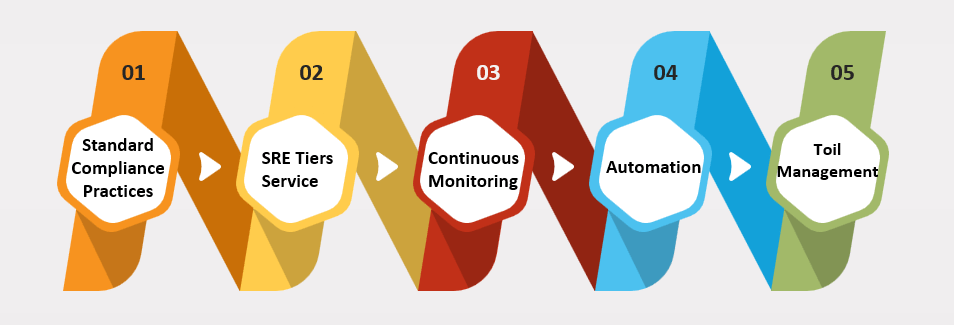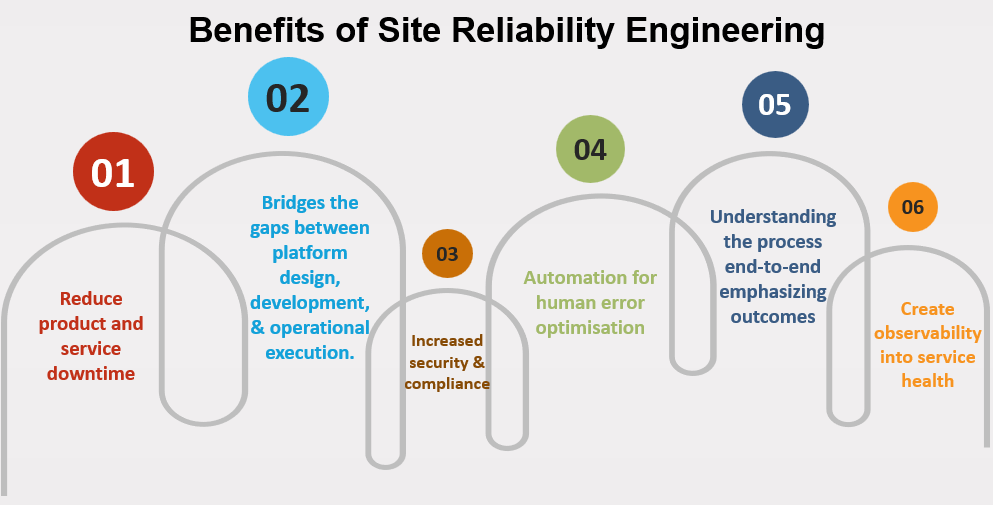What is Site Reliability Engineering?
Site Reliability Engineering (SRE) ensures software engineering as an error-free IT process, by applying software engineering approaches and automation solutions to system administration topics. SRE uses software programs as a tool to regulate systems, troubleshoot issues, and automate the operational process.
The SRE becomes the most crucial component for major market players. Businesses like Amazon, Flipkart, and Google may have to face trillions of dollars in losses if their systems go down even for a minute. To curb such situations, organizations need to figure out how to provide redundancy, and fault tolerance, and ensure a consistent user experience.
SRE’s Growth
In recent years SRE has grown in importance. It connects software operations with greater user experience expectations, as well as IT operations and developers. On the other hand, it is a field that comprises a range of concepts and solutions for overcoming infrastructural and operational problems. SRE assists teams in striking a balance between releasing new features and ensuring reliability for users.
SRE eliminates most of the natural resistance that arises between development, production, and operations teams who seek to deploy new or updated software on a continuous basis. Companies are cautious to release any upgrade or new software unless they have assurances that it will not cause outages or other operational issues. These engineering concepts include a data-driven strategy for operations, an automated culture to increase efficiency and reduce risk, and a hypothesis-driven approach to incident, efficiency, and capacity duties.
The notion of site reliability engineering is credited to Ben Treynor Sloss of the Google engineering team.
The founder, Mr. Ben Traynor describes the SRE in the interview as:
“Fundamentally, it’s what happens when you ask a software engineer to build an operations function… So SRE is essentially doing work that has traditionally been done by an operations team but using software engineers and banking on the fact that these engineers are both predisposed to and capable of substituting automation for human labor.”
Practicing SRE is more beneficial when it comes to building scalable and highly reliable software systems. It administers the massive systems via code, which is more scalable and long-term for system Admins who manage a huge number of machines.
The SRE paradigm has two key components: standardization and automation.
Engineers in charge of site dependability should continually be searching for methods to improve and automate operational chores.
Best Practices for an enhanced Site Reliability Engineering.
In general, independent of the SRE model utilized, there are several significant ways that have a large impact. Listed below are a few of them:

Practices and requirements:
A set of operational reliability and performance standards should also be developed and promoted by the SRE team. The amount of hard work and repetitive occurrences are reduced, and the customer experience improves dramatically when everyone in the company adopts them. By establishing a personal example and enforcing mandatory compliance from company leaders, the SRE team may find things simpler for someone else to meet those standards.
SRE Tiers service:
Sometimes it is hard to decide when there are multiple development teams, applications, or infrastructures to support, and the depth of involvement shown by the SRE teams. It is unrealistic to be an expert in everything, but a person can be 100% productive by putting in 40 hours per week. The individual should be capable of quickly responding to questions and resolving the problem.
The tiering SRE is the ideal approach and here’s an example:
- Tier 0: No dedicated SRE employees or consultation
- Tier 1: Dedicated effort and time on projects
- Tier 2: SRE work on-call with dedicated time
Monitoring:
The SRE team must understand their systems in and out to identify the performance faults and guarantee uptime. The maximum system performance can also be achieved with continuous monitoring. This comprises providing a service, meeting set goals, and understanding what happens when a change is made.
Bring Automation:
The companies must adopt a process of quickly delivering the products with quality. As a result, speed and accuracy work together to make a system reliable and most businesses seek to make their systems as reliable as possible without slowing down their process. This saves time by eliminating time-consuming and repetitive tasks, which can be used to automate the process.
Toil Management:
When it comes to engineering time, toil is the most significant drawback; it is a waste of valuable time. In the beginning, having very few modules to configure with a minimal setup could seem convenient. As the project grows, the number of modules grows, making it more difficult to manage the process setup and configurations. Spending some time on creating a framework that can execute multiple functions and implementing automation can significantly reduce the developer’s workload.
Benefits of Site Reliability Engineering:
Some benefits of incorporating SRE culture and practices are improved customer experience, greater revenue, cross-team cooperation, decreased operational toil, self-learning, data-driven insights, and improved service reliability. Some of them are discussed below:

Reduce product and service downtime
You’ll need SRE knowledge to keep your products and services working as smoothly as possible. We all know that supporting continuous integration and testing by the operations team helps to reduce downtime. They make sure that the most services are available along with increased revenue. As a result, businesses that use SRE regard their IT operations as a value center. To be more productive the SRE team requires SRE management experience and as employees’ skillsets develop over time, they become more productive.
Creates observability into service health
The team ensures that the observability is already in place when the incident occurs, allowing the call responders to locate the required context which enables them to resolve issues more quickly.
Understanding the process end-to-end emphasizing outcomes
The concept of a site reliability engineer is significant in the DevOps framework as another approach to connect Ops and Dev. SREs define a role whose major purpose is to connect people and streamline processes. Increasing reliability necessitates a reduction in complexity across a variety of operations. The process must be simplified as your company grows. Unfortunately, as more people are added to an organization, it increases complexity, reduces transparency, and wastes work. SREs are attempting to comprehend processes from beginning to end, focusing on outcomes rather than specific process stages.
Bridges the gaps between platform design, development, and operational execution.
By delivering unique insights into system dependability, site reliability engineering fills a gap in platform design, development, and operational execution. When software engineering and systems engineering approaches are combined with operational engineering, the support of a product that is focused on business objectives rather than ticket output is streamlined.
This can be a smart alternative to the standard technique that pays off handsomely for businesses. Provides a better understanding of the platform, reduces the product support effort, and sustains it by sacrificing specializations in favor of focusing on operational load. Instead of laborious, reactionary troubleshooting, it allows developers to spend more time automating and inventing to create self-healing and auto-scaling products.
Increased security and compliance
Site Reliability Engineering is concerned with security. It has become even more important than reliability, scalability, efficiency, and performance of services whenever there has been a specific breach. The most typical action is to halt development and have the teams focus on resolving the vulnerabilities. Another method is to utilize security gates on the CI/CD pipeline to prevent new deployments.
At this point, I’d like to bring up the Equifax data breach, that exposed over 140 million social security numbers in 2017.
“On March 7, 2017, a critical vulnerability in the Apache Struts software was publicly disclosed. Equifax used Apache Struts to run certain applications on legacy operating systems. The following day, the Department of Homeland Security alerted Equifax to this critical vulnerability.
Equifax’s Global Threat and Vulnerability Management (GTVM) team emailed this alert to over 400 people on March 9, instructing anyone who had Apache Struts running on their system to apply the necessary patch within 48 hours. The Equifax GTVM team also held a March 16 meeting about this vulnerability.
On May 13, 2017, attackers began a cyberattack on Equifax. The attack lasted for 76 days. The attackers dropped “web shells” (a web-based backdoor) to obtain remote control over Equifax’s network. They found a file containing unencrypted credentials (usernames and passwords), enabling the attackers to access sensitive data outside of the ACIS environment. The attackers were able to use these credentials to access 48 unrelated databases.”
Equifax Breach Congressional Report
Automation for human error optimization
Organizations must investigate all options for reducing downtime, particularly more than 22% are linked to human errors. As a result, disruptions can be greatly reduced by automating IT tasks such as monitoring. Automation is an important part of SRE because it improves the dependability, resilience, and precision of operations by automating manual, repetitive, and redundant procedures.
SRE makes use of the self-healing process to identify typical mistake scenarios early in the process and automates simple recovery procedures. This speeds up incident response by reducing the meantime to repair and the cost of fixing errors. To make observations and improve the process, SRE employs intelligent data-driven methodologies.
How can Impelsys’ Site Reliability Engineering team help your company drastically reduce downtime?
Impelsys’ passionate and talented Site Reliability Engineering Team provides our customers with the finest quality services to scale global applications and infrastructure while ensuring high availability. As more cloud-based services become Software as a Service (SaaS), it’s critical that they remain stable under changing loads and peak situations. The Impelsys SRE team optimizes Cloud service processes by continuously monitoring, rectifying, and evaluating them for fault tolerance, process accurateness, and scalability.
Connect with us:
Looking for an Expert Team that can help you bring your vision to life? That’s exactly what our team of ideators, business consultants, architects, and engineers have done for our clients over the years. Leveraging over 20 years of rich technology experience, Impelsys is diligently creating technology solutions with our tried-and-tested digital transformation approach and application engineering expertise to drive business growth across industry verticals. To learn more, visit Impelsys or write to us at marketing@impelsys.com to get started.
Authored by –
